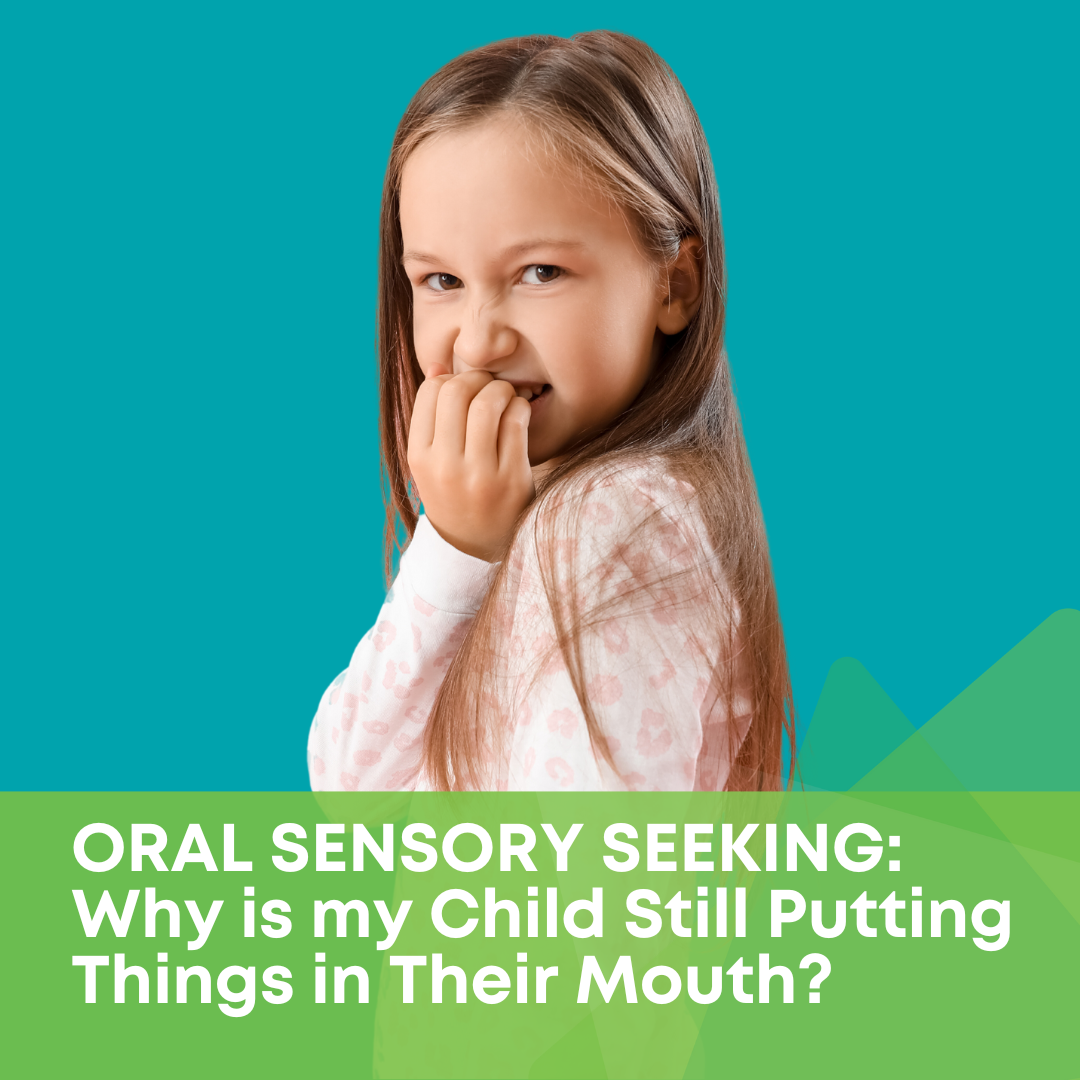
Let’s explore oral sensory seeking
Children often stop mouthing and placing objects into their mouth after the age of two. However, some children may still seek to play objects into their mouth, and this might include to chew or suck on non-food objects, suck or chew their sleeves or collar, or constantly have a toy or pencil in their mouth. In some cases, they may also eat non-food items.
Oral seeking is part of normal development.
Oral sensory seeking behaviour, or mouthing items, is a normal behaviour in babies and infants. They use sucking to help to calm themselves and self soothe. This self-soothing can also be called self-regulation. It explains why dummies or pacifiers work so well to help calm down an upset baby. Sucking is also an important survival reflex, which is essential for feeding.
As they get older, infants then use their mouth to explore the world. It is very normal for children to put everything into their mouth between the ages of 18-24 months. This helps their sensory motor development. It helps them to learn more about an object, such as how big is it, how hard or soft is it, and its shape. The mouth acts like a second pair of eyes, giving the brain extra information about the objects in the world. This behaviour typically reduces from eighteen months, but it can continue until two years of age.
What might it look like if a child is oral sensory seeking?
For children that are over two years of age, you might continue to see these behaviours past this age. Remember these behaviours are very normal in children under two years of age. However, past the age of two they would be less common.
Putting toys into their mouth and sucking chewing them.
Chewing or sucking their collar or sleeves
Putting their pencil in their mouth
Chewing pieces of paper
Sucking their thumb or biting nails
Common reasons a child might still be putting things in their mouths past the age of two
We just want to again emphasise that it is really normal for children under the age of two to mouth items. The frequency can also increase when children are teething, again completely normal behaviour. Here we will discuss some reasons that older children might continue with oral sensory seeking past this age.
1. The child has developmental delays
As noted above, children use their mouths to explore objects and their world. Older children with developmental delays may continue to use their mouths to explore objects like an 18 month old does as this reflects their developmental age. So, despite on paper being older as they have had their birthday, their brains are still processing information at a much younger age level. They are still working in the sensorimotor stage of development. This is why they are still putting things in their mouth as it is normal for this developmental stage. Their behaviour is essentially reflecting the developmental age rather than their actual age. These children need more time to develop past this stage than their typically developing peers. We give some suggestions of appropriate activities below.
2. The child is using the oral sensory seeking input to self-regulate or self-soothe.
As we said above, sucking is very calming. It is a strategy that babies use to help self soothe and regulate. Some children continue to use this strategy even when they are older. It can be a useful sign that your toddler or young child is upset, tired or overwhelmed. It can also be an indicator that they do not have another strategy to use to help themselves calm down.
3. The child is experiencing sensory overload
Children with sensory processing difficulties can put things in their mouth or chew when they are overloaded too. Chewing is also seen in children with autism and sensory issues. Sensory overload occurs when the child or adult has experienced too much sensory input from their environment. Their brains become overwhelmed by the amount of information that they have to process. They, therefore, use the oral sensory seeking to help with self-regulation. Chewing and sucking helps to self soothe so it is a strategy that children and adults use to help to calm themselves down if they are experiencing sensory overload. Because the jaw is one of the most powerful muscles in the human body, chewing gives the brain a big hit of proprioceptive sensory input. We explore some ideas to help below, so, keep reading.
4. In some cases, the child may have problems with their teeth
In some cases, the child may have problems with their teeth. It may be that their adult teeth are cutting through. However, it could also be a sign of decay, or infection. If this is suspected, the child should have a checkup with their dentist.

When is oral sensory seeking a ‘problem’?
Many children will continue to suck their thumb and chew on items after the age of two. This helps them to calm and self sooth. It can be a really helpful strategy when it is functional. Oral sensory seeking can, however, be a problem if the child is zoning out when they are chewing or sucking items and therefore not listening in class. It can be a problem for some children as they develop a rash around their mouth, which can be painful and cause discomfort. Some children end up destroying their clothing or other items because they are mouthing or chewing on them excessively. As the child gets older it can also be a problem as it makes them stand out from their peers and can lead to bullying and also affect self-esteem.
How can I help?
Developmental delay
Where you feel the oral sensory seeking is related to a developmental delay, then it will be important to provide your child with developmental age appropriate activities. These may be games and activities that are designed for younger children, rather than their actual age. I recommend toys that are designed for under two years and are therefore safe to mouth. You can be quite creative with this. Look for toys with different textures. If the child is able to eat safely, you can also use harder food items, such as teething rusks, long carrots or broccoli stems. Different temperatures can give variety.
Your child will also likely enjoy sensory play activities such as water play, corn flour or edible finger paints, general toys with light, noise or vibration. You must just make sure that any item you are using is safe to be put in their mouth and cannot be accidentally swallowed. In addition, children who are oral sensory seekers benefit from whole body play and games. This includes swings, sand pits, messy play, soft play areas, swimming, etc. For children in wheelchairs, we would definitely recommend seeking out a wheelchair swing or sensory play space they are able to access.
Oral sensory seeking to help with self-regulation and sensory overload.
Here, it will depend on what your child is putting into their mouth and when. Firstly, it is helpful to identify if there is a pattern to the oral seeking behaviour. Does it happen more often at home or at school? Is it happening more in the morning or the evening? What events or activities trigger it? It is happening more often when your child is tired? Does it happen more when they are worried? Could they be overloaded? Might they be bored?
If there is a pattern then you may be able to identify what is increasing your child’s arousal. If it is a time of day then you could try some of the suggestions below to help your child to stay a bit calmer at this time. When there is a specific event or activity you may be able to modify the activity to make it easier for your child to manage. Or, if you think they are bored, you could find another activity for them to do.
If you think it is more linked to sensory overload, then you will need to consider how this sensory overload can be reduced during their day. Some of the oral activities below may help with regulation. Heavy work can also be a useful strategy. Your child may also benefit from assessment by an occupational therapist trained in sensory integration.

Sensory activities to help children who are oral sensory seeking
Please note many of these activities include food. It is expected that the adult using the suggestions considers any allergies or dietary requirements the child may have. As a general rule, chewing and sucking have a more calming effect. Crunchy textures can be more alerting, but in some cases can also help to reorganise.
General oral activities to help children oral sensory seekers include:
Musical instruments such as a harmonica, or recorder
Whistles
Party blowers
Bubble blowing – you can use bubble straws for children who can’t use regular wands
Drinking drinks through a straw
Water bottles, such as a camelback, that require a strong suck to release the water.
For children that prefer sucking you can try:
Frozen fruit to suck
Ice cubes to suck
Sugar free hard lollies / candies
Lollypops
Homemade frozen juice sticks (using fruit juice)
If your child prefers crunchy textures you could try:
Ice cubes
Popcorn
Dried banana chips
Dehydrated vegetable chips/crisps
Crunchy muesli
Nuts
Crunchy muesli bars or flapjacks
Raw carrot sticks or other raw vegetables.


